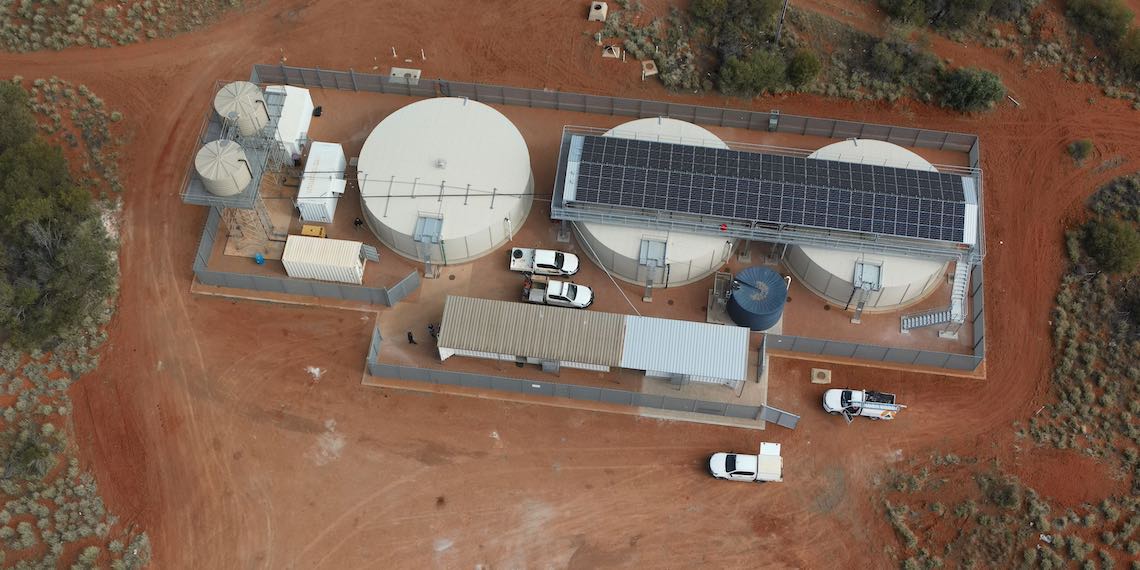New desalination plant to deliver drinking water to remote SA Aboriginal community

A new desalination plant built in the remote north-west of South Australia is seeing SA Water deliver on its commitment to provide water to its customers across the state.
Serving the 220 people of Kaltjiti, an Aboriginal community on the Aṉangu Pitjantjatjara Yankunytjatjara (APY) Lands, the upgraded reverse-osmosis plant uses updated technology to deliver up to 120,000 litres of high-quality drinking water each day.
“Technology advances over the years, so we are using some more modern equipment, but like its predecessor, the new plant is still powered by solar panels and some battery storage,” said Clare Hesketh, Media Relations Manager at SA Water.
“It's also still using reverse-osmosis technology to remove impurities like high levels of naturally occurring salinity, which is pretty common in large groundwater sources. The Kaltjiti desalination plant sources its water from groundwater, as do a lot of our remotely located desalination plants.”
Although the use of solar panels and batteries ensure the plant can be reliably operated and maintained in this remote area, Hesketh acknowledged the power source did introduce some complexities.
“There's a lot of challenges when it comes to operating remotely located infrastructure. Although a lot of sunlight can be a good thing in terms of trying to power solar panels, it can also be a bit difficult,” she said.
“Along with general reliance on very small-scale electricity generation in remote areas, like the APY Lands, it can present some issues when it comes to designing and then making sure we can maintain infrastructure in those areas.”
Remote control
Those efforts are helped by the utility’s ability to monitor the equipment from as far away as Adelaide.
“We are able to continue operating different infrastructure reliably and sustainably through the use of renewable energy as well as the ability to remotely control, operate and monitor the performances of those plants,” Hesketh said.
“At Kaltjiti – and a lot of the other plants in the APY Lands – there's a high-tech computer system which our dedicated remote communities team, who are based in Adelaide, can monitor … all the way up to the Western Australian and Northern Territory border.
“They can see if there's any faults and action them, if they're able to do that remotely. But we also have local contractors who we can work with if we do need someone to go out there physically to inspect the infrastructure.”
The reverse-osmosis technology used by the plant is suitable for the particular needs of remote communities like Kaltjiti.
“This is definitely a proven technology that we and other water utilities around Australia use for those inland groundwater – bore water – sources,” Hesketh said.
“Bore water tends to have the naturally occurring high levels of salinity, but also has levels of naturally occurring fluoride, so we use reverse osmosis along with other types of the treatment process to make sure that those levels are complying with the Australian Drinking Water Guidelines.”
But the plants are also used on a larger scale for some of the state’s urban water requirements.
“We've got bigger desalination plants, such as at Lonsdale down on Adelaide's coast, which is a lot bigger plant than the one at Kaltjiti or any of our other ones in the APY Lands,” Hesketh said.
“I will say though, what the plants in the APY Lands lack in size, they do make up for in ingenuity. It's quite innovative to have plants operating in such remote areas still being able to deliver high-quality drinking water to those local communities.”
Time to upgrade
The new desalination plant replaces one that had been in operation since 2005.
“It had reached the end of its useful asset life, so we began a process to design, plan and then construct a replacement facility,” Hesketh explained.
“When the new plant was being constructed, we were able to keep the previous one in service, so it meant that the community could continue to have that reliable supply of safe drinking water throughout the construction period.”
And ensuring the infrastructure was ready came with some challenges, too. Hesketh said it was important to work with the local community to confront difficulties distinct to the area.
“The soils are not as easy to work with when installing some underground pipelines. It's definitely a challenge, and we use the expertise of some local contractors and the expertise of our people who have been working in those regions for quite a while, to understand some ways around that,” she said.
“There are of course local bits of knowledge that we don't necessarily know that we do rely on the communities to engage with us about.”

